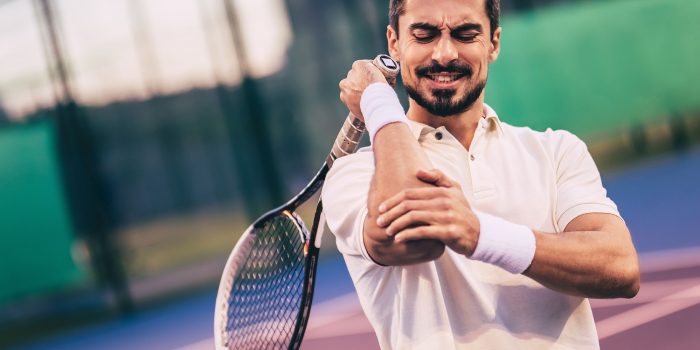
The grasping pain of tennis elbow
July 15th, 2024Tennis courts are just one place where you can find people suffering from tennis elbow. The repeated first serve, second serve, ace, backhand and volley can result in trauma to that part of the arm where the tendons join the forearm muscles to the outside of the elbow. Repeatedly hitting anything or putting the elbow under strain can cause grasping pain, aching and weakness. Hence, we are all at risk of developing tennis elbow not just the big hitters at Wimbledon.
First documented in 1883, a type of tendinitis otherwise known as lateral epicondylitis, tennis elbow can cause months of discomfort. Generally experienced by those aged between 30 and 50 other symptoms include a burning sensation and stabbing pain.
Tennis elbow is the most common reason for elbow pain and discomfort that can get progressively worse. Raking the leaves, digging, typing, knitting, playing squash, weightlifting, building and decorating are other examples where the elbow can become strained resulting in tennis elbow.
How is tennis elbow diagnosed?
- Medical examination
A doctor or specialist can make a diagnosis by asking questions and examining the elbow
- X-ray
An ex-radiation (x-ray) can reveal unusual bone structures that might be causing soft tissue damage to tendons and muscles
- MRI
Magnetic resonance imaging (MRI) scans can show a condition known as oedema which is a thickening of partial tears
- EMG
An electromyography (EMG) detects muscle and nerve complications. They can detect and read transmitted nerve signals
How can tennis elbow be treated?
- Visit your doctor for diagnosis and advice
Your doctor will be able to recommend treatments. If natural remedies are a preference, do ask for information about what you would like to try and if the doctor thinks it is appropriate for you. Pre-existing health issues and prescribed medication will need to be taken into consideration
- Visit an elbow specialist
The elbow specialist will probably be an orthopaedic surgeon. Ask your doctor for recommendations
- Stopping the activity causing the issue
Once the cause of the condition is found, stopping or reducing that activity will decrease and eventually should cure the discomfort
- Rest
Rest allows the small tendons to heal. The healing time can take anywhere from two weeks to six to twelve months
- Ice packs
Ice causes an increase in blood flow. It helps to reduce inflammation and pain and can improve range of movement
- Strengthening exercises
Exercise can increase the pain but sometimes, with advice and guidance, it is worth working through the discomfort because strength training supports tissue healing
- Stretching exercises
Stretching the wrist extensors and flexors and stretching the hand can bring some relief to elbow pain
- Anti-inflammatory medication
Non-steroidal anti-inflammatory drugs (NSAIDs), for example, ibuprofen can be used to manage the pain. It can be applied to the skin with gel or by tablet
- Compression
Wearing a compression sleeve can provide additional support to the elbow. It won’t heal the condition and shouldn’t be worn for long periods
- Massage
Deep tissue massage to the forearm is a very effective method to ease elbow pain
- Herbal
Arnica, turmeric and ginger are known to contain anti-inflammatory properties
- Essential oils
Lavender, peppermint and eucalyptus are known to contain analgesic and anti-inflammatory properties
- Acupuncture
Thin needles are inserted into specific points to stimulate energy flow and promote healing
- Precise frequency vibration therapy
There are products on the market that you can use at home. Small devices can be used to send precise frequency vibrations (shockwaves) to block pain and stimulate healing
- Bracing
Using an arm brace applies pressure to the muscles and tendons of the forearm reducing the pressure on the injured tendons
- Steroid shots
Steroids can be injected into and around a joint or muscles to help alleviate pain and reduce swelling
- Ultrasound shock wave therapy
Extracorporeal shock wave therapy (ESWT) is a non-invasive treatment using high-energy shock waves to stimulate the body’s healing system
- Platelet-rich plasma therapy
Platelet-rich plasma (PRP) therapy involves patients receiving an injection of a concentration of platelets to quicken the healing
- Surgery
A surgeon repairs the damaged tendons using something called a suture anchor or stitches tendons together
How can you prevent tennis elbow?
- Stop or reduce repetitive movements
- Keep arms flexible
- Do strength training
- Warm-up and cool down properly
- Use the correct equipment for your activity
Experiencing tennis elbow can be frustrating and limiting. Combining comprehensive treatments with alternative therapies can help manage and alleviate the discomfort.
Get elbow smart to enjoy a game, set and match in whatever you do.
We recommend our product JointPro peptide cream for joint pain, arthritis and tendon injuries. It is a unique peptide-based cream that relieves pain in the joints, muscles and tendons.
References
- https://stanfordhealthcare.org/medical-conditions/bones-joints-and-muscles/tennis-elbow/diagnosis.html#:~:text=X%2Drays%20aren’t%20usually,show%20soft%20tissues%20very%20clearly.
- https://www.intercoastalmedical.com/2021/03/19/what-are-the-symptoms-of-tennis-elbow-and-how-is-it-diagnosed-by-a-doctor/#:~:text=Doctors%20usually%20request%20an%20EMG,conditions%2C%20such%20as%20nerve%20entrapment






